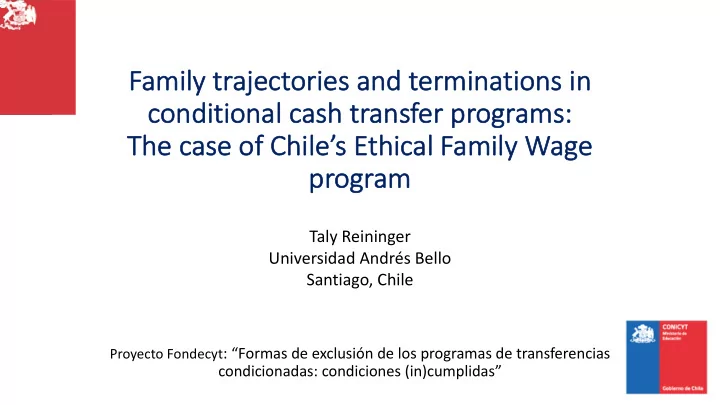

Fa Family trajectories and terminations in co conditional ca cash transfer programs: Th The case of f Chile ile’s Ethic ical l Family ily Wage pr program Taly Reininger Universidad Andrés Bello Santiago, Chile Proyecto Fondecyt : “Formas de exclusión de los programas de transferencias condicionadas: condiciones (in)cumplidas”
Con Context • Brief history of Chile’s CCT programs • The Ethical Family Wage Program, 2013 • Non conditional, conditional and achievement cash transfers • Psychosocial and employment case management • Previous research on program trajectories and terminations
St Study Method odol olog ogy • Analysis of program registry from the Ministry of Social Development program. Data base included: • Individual, family and program variables including program status. • Analysis only of families who entered program between January 1 and December 31 st , 2014. • total of 52,084 families. • Study sought to identify variables that could explain program termination.
Finding Findings • In its implementation program deviates sharply from its theoretical framework. • 9 Family categories (Assessed, finalized, not localized, terminated, amongst others) • 90% of families only complete up to a maximum of 6 psychosocial sessions. This includes families who completed the programs 24 month duration. • Probabilities of facing termination: • Greater probabilities of termination in families with younger heads of households, female and single headed households, larger families, households with higher education levels, those with informal employment, and families who participate in both the psychosocial and socio-employment case management. • Less probabilities of termination in families with homeownership and greater number of children.
Con Conclusion ons • Low adherence to psychosocial (APS) and social employment (ASL) case management component of the program. • Area for future research. • Families participating in both the APS and ASL were more likely to face termination. • Is this due to over-intervention? • Complex findings in terms of program terminations: • Some variables associated with greater vulnerability while others associated with higher levels of social and cultural capital.
Recommend
More recommend